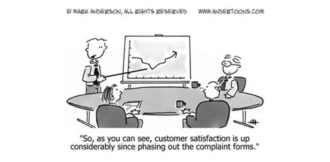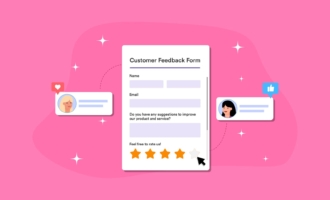If you’ve ever sold anything on eBay, you know the importance of customer feedback. A color-coded star rating and positive reviews can boost your reputation and drive new business.
On eBay, customers leave feedback for an estimated 20 to 30 percent of successful purchase experiences. But when a transaction goes bad, 90 percent of customers will leave feedback, and this phenomenon isn’t limited to eBay. A business will usually hear from customers when they’re unhappy. When things go well, customer feedback might not be as forthcoming.
A steady stream of customer feedback is crucial for a business owner, and not just when something goes wrong. When you’re in touch with customer sentiment — good, bad, and neutral — on an ongoing basis, you’re better positioned to fix problems quickly and effectively, which can help your company grow.
But customer feedback doesn’t just happen. Sure, you might be lucky enough to have a conversation with a customer in passing or read customer reviews about your product or service online. But this won’t be enough to provide a comprehensive picture of customer sentiment, and it won’t create an organized pool of feedback data that can support smart decision-making.
You need well-defined systems and processes for soliciting, collecting, and categorizing feedback, so you can act upon it in the most appropriate and effective way. You can also develop processes to follow up on customer feedback, helping build trust and reciprocity with customers to drive real change for the better.
This guide will cover the principles of customer feedback, how it works, and tips to integrate customer feedback into your business. Topics include
- The definition of customer feedback
- Reasons why you need to use customer feedback
- Different types of customer feedback and how each works
- The customer feedback loop and all its stages
- How to request customer feedback
- How to collect customer feedback
- How to categorize customer feedback so you can derive powerful business insights from it
- How to act on customer feedback
- Why following up on customer feedback can make a big difference in your business
- Tools and tips to support your customer feedback strategy
Customer feedback is about much more than a business’s image. It helps you know what’s working and what’s not, and where your business needs to improve — from the perspective of your most important asset: your customers.
Let’s get started.
Customer feedback and why it matters
The concept of customer feedback is as old as the trading of goods and services. The first recorded example of a customer complaint was recorded in 1750 BCE when a customer named Nanni complained about a shipment of iron ore received from supplier Ea-nasir. Nanni complained about delays and the product not meeting expectations. Written on a clay tablet, the ancient customer complaint can be viewed today at the British Museum.
Although it might not always seem like it, customer feedback is more than just a way for unhappy customers to vent.
What is customer feedback?
Customer feedback is information provided to a business that describes the customer’s thoughts, experiences, and reactions about that business’s products and services. Customer feedback can be casual, like when a business owner chats with a customer in the store about how they enjoyed their last purchase. It can also be highly structured and formalized, such as feedback gathered from a survey, focus group, or customer review website.
5 reasons to love customer feedback
When managed properly, customer feedback is a powerful tool with several functions. Here are five ways that customer feedback can help a business:
1. It gives customers a voice
Customers are your business partners — perhaps the most important ones. Especially today, when social media offers opportunities for direct communication, customers expect to be listened to, appreciated, and cared for.
It only takes up to three bad experiences for 92 percent of customers to leave a business. Customer feedback facilitates and enhances the connection between your business and customers.
2. It builds loyalty and trust
Customer feedback works as a loop of positive reinforcement. A company requests feedback from customers, making them feel empowered and appreciated. As long as the feedback is received in good faith and acted upon appropriately, customer trust and loyalty will only increase. This leads to positive reviews, which enhance your business’s reputation and attract new customers.
3. It helps improve products and services
There’s no one better positioned to critique your product or service than your customers. They have already bought it, used it, and can help you pinpoint how to make it better.
It’s a great idea to survey customers and find out what they like and don’t like about your offerings. You can use this information to upgrade product design, alter pricing, implement new features or package options, and incorporate other adjustments to make customers happier.
4. It measures customer sentiment
Running a business includes many moving parts, so it can be difficult to take the time to consider what customers are thinking. However, customer sentiment is a vital benchmark of business success.
A company launches a new product, and sales are good. But what do customers really think about the product? How are they using it? Would they recommend it to friends or buy it again?
All these questions can be addressed with customer feedback. With a customer feedback system in place, measuring customer sentiment becomes a built-in component of a business’s decision-making process.
5. It helps drive innovation
One of the great things about customer feedback is how it can lead a business toward what the target audience really wants. For example, the pro-diversity underwear brand TomboyX launched its unisex boxer briefs as a direct response to a customer request. The product has since become a best seller.
Case in point: Customer feedback can drive innovation and open up new avenues of profitability that your business may not have thought of before.
Gathering customer feedback isn’t hard to do
You don’t need an MBA or the services of a strategist to begin gathering, analyzing, and reaping the benefits of customer feedback. Nor does a business need a complicated, expensive software system to properly collect and use customer feedback.
There are a handful of simple steps any business owner can take to collect customer feedback. For example, why not add a feedback button to your company website? This invites customers to provide their opinion and shows them that the company wants to hear what they have to say. Plus, it’s free and doesn’t require special coding to implement.
Let’s explore the different types of customer feedback and the various ways businesses can request and collect it.
Types of customer feedback
Not all feedback is the same, and businesses need to collect different types of feedback to form a complete picture of customer sentiment.
The type of customer feedback that’s most appropriate and useful depends on the business and its offerings. Businesses that sell products need to know what customers think of the product’s features, functionality, and quality. They can get this kind of feedback via customer reviews or product ratings.
Alternatively, if a company offers a service, it needs feedback on aspects such as customer support, service quality, the ability to meet deadlines, and communication. These can be assessed with surveys or email campaigns.
The most common types of feedback your business can use
The three main types of customer feedback are given feedback, requested feedback, and observation feedback. Let’s take a closer look at each one.
Given feedback: Build it, and they will come
Given feedback is something the customer provides with no prompting from the business. Basically, the feedback isn’t requested — rather, the customer initiates the feedback on their own.
Unfortunately, this type of feedback is usually given in response to a problem. Many customers will reach out to complain or notify management about an issue. Satisfied customers typically don’t take the time to reach out and say how happy they are with a transaction.
Most often, given feedback comes in the form of calls to customer hotlines or support requests to the customer service department. In other cases, given feedback occurs within a framework already set up for it.
For example, sites like eBay and Amazon have built-in feedback systems that customers can use. Sellers don’t request feedback per se, but the channel is already in place. You can increase your given feedback by creating your own feedback channels and providing customers with ample opportunities to provide feedback.
Requested feedback: If you don’t ask for it, you don’t get it
While customers sometimes initiate the feedback process, it’s not enough to rely on given feedback. Businesses can increase the flow and quality of customer feedback by asking for it. This is known as requested feedback.
You can collect requested feedback via surveys and questionnaires sent by email. To incentivize customers to fill out the survey, offer a small participation gift.
Focus groups and customer interviews are great ways to get more in-depth and detailed feedback. Flash polls, like those that randomly appear on a web page, can be effective for getting quick feedback on a time-specific issue.
The secret to getting great requested feedback is asking for it at the right time and place. For example, it makes sense to request feedback about a product only after you have given the customer enough time to form an opinion of it.
Observation feedback: Actions speak louder than words
You can gain significant insight not by listening to what customers say but by watching what they do, also known as observation feedback.
For example, by monitoring support tickets or tech support requests, businesses can get a good idea of the issues customers are having with their products. Another way to gather observation feedback is by tracking customer activity online, such as the most popular articles or highly searched topics and products on a business’s website.
Email campaigns can also provide observational feedback. For instance, email open rates or churn rates (how many customers unsubscribe from email lists) provide a clear picture of customer engagement and interest levels.
Observation feedback is a gold mine because there’s no limit to the ways a business can collect and use it. Almost every interaction with customers is an opportunity for observation feedback.
A circle of growth
Whichever types of customer feedback you use, it’s important to remember that customer feedback isn’t a one-way street. It functions as a loop, driving insights that lead to follow-ups that ultimately drive even deeper insights. There’s no end — only an efficient feedback process that helps a business improve and grow.
The customer feedback loop
Ever heard the screeching of feedback from a microphone? That’s what happens when the sound entering the mic is picked up by the speaker and amplified again.
Think of customer feedback the same way (but without the annoying screech). Getting feedback from customers is never about just letting them talk. It’s a two-way interaction that occurs on repeat. That’s why it’s often described as a “loop” — in business strategy, it’s also known as the ACAF Customer Feedback Loop.
ACAF — which stands for ask, categorize, act, and follow up — provides a framework for an ongoing, self-driving flow of customer feedback that’s useful and effective in the long term.
Gathering customer feedback is just the first step in the process. What businesses do with the feedback data will determine its value.
To get the most out of customer feedback, you have to organize and process it, create actionable insights, and then examine the impact after you’ve implemented it. This is why the ACAF Customer Feedback Loop is so helpful; it creates a structure around the messy business of customer feedback.
To get the loop started, request feedback from customers.
Now, let’s see what a powerful customer feedback loop looks like and how it works.
How to ask customers for feedback
Feedback initiated by customers is great — but it’s not nearly enough.
Businesses that constantly generate customer feedback have a much larger pool of data to support positive decision-making. Also, a rich and active customer feedback loop facilitates dialogue to help improve products and services, and increase customer satisfaction — the key to building a strong, long-lasting business.
But customer feedback won’t appear out of nowhere — to keep up the feedback flow, businesses must be proactive. And that means making the first move and asking customers directly for feedback.
Ask what, exactly?
Before popping the feedback question, it’s wise to take a look at the different customer feedback techniques commonly used by businesses. Here are the most popular and effective customer feedback methods.
Net Promoter Score (NPS)
Would customers recommend your product or service to their family and friends? This is the question the Net Promoter Score (NPS) is designed to answer.
NPS is easy to put into action. Customers rate their likelihood of recommending the business on a scale of 1 to 10. Those who respond 9 or 10 are considered “promoters,” 7 to 8 are “passives,” and those scoring under 6 are “detractors.”
The total NPS score is determined using the following calculation: percent of promoters – percent of detractors. The higher the NPS score, the more likely that customers are happy to recommend the business.
NPS helps businesses understand whether customers are satisfied right now while also providing a reliable indicator of potential growth. After all, customers who are happy with a business will be more inclined to recommend it and bring in new customers, while those who are dissatisfied won’t.
Customer Satisfaction Score (CSAT)
The Customer Satisfaction Score (CSAT) is one of the simplest customer feedback scoring methods. It’s based on the question, “How satisfied were you with your purchase/experience?” Answers are given on a scale of 1 to 10.
CSAT is useful for measuring customer satisfaction with products and services over time. The same question asked on the day of purchase, compared to one month or two months later, can provide a big-picture glimpse of the customer’s experience and how it changes.
The fact that the CSAT is such a straightforward and fast feedback technique means that businesses can use it several times with the same customers without being a nuisance.
Customer Effort Score (CES)
This metric can help determine the ease of interaction between customers and a business. The Customer Effort Score (CES) isn’t a numerical measurement. Rather, it’s based on a scale of “positive” to “neutral” to “negative.”
Here’s an example of a typical CES question: “How helpful was your customer service experience today?” The answer scale includes the following answers, from best to worst:
- Very helpful
- Helpful
- Neutral
- Unhelpful
- Very unhelpful
The total CES score is calculated by subtracting the percentage of positive responses from the percentage of negative ones. A low average customer effort score means customers have to work hard to get what they want from the business, while a high average means customers are getting what they want without having to put in a lot of effort. The CES can help determine where customer interactions can be improved.
While those three methods of getting customer feedback are fairly common and straightforward, knowing how to ask customers for their feedback is another story.
Turn on the channels: How to get customer feedback
You can collect customer feedback via any of the channels you use to communicate with customers. These include email, phone calls, SMS, popup messages, social media, and even face-to-face conversations. However, a solid customer feedback strategy will formalize these interactions and gather the feedback data in such a way that it can be analyzed and transformed into a purposeful action plan.
Here are some of the most common ways to get customer feedback.
Live chat
Live chat support channels can collect feedback either with person-to-person interactions or automated feedback surveys. For example, at the end of a live chat support conversation, the representative can wrap things up with a quick question such as, “How would you rate the service you received today?” The customer can either type in free text, which is recorded and collected later, or select an automated star rating or multiple-choice answer presented in the chatbox.
Live chat feedback is effective because it’s instant and accurate. The customer has just finished interacting with the business, and their experience is fresh in their minds.
Surveys
Surveys are a popular way to ask for customer feedback because they are fairly easy to create and distribute. You can customize surveys with the best format and questions for the situation. For example, if you’re conducting a market research survey to gauge interest in a new product, a question like, “Have you used a product like this before?” will help create a picture of the competitive landscape.
A business that wants to refresh its website can conduct a user experience survey to find out what kind of design and features customers prefer before launching into the creative process. Surveys can include various customer feedback techniques, such as Customer Satisfaction Scores, to build a solid data set that supports actionable insights.
Forms
Customer feedback forms are a popular way to collect detailed feedback, as the format allows for more complex and varied question styles. Feedback forms can include yes-no questions, rating scales, and multiple-choice questions as well as free-text responses, giving customers the space to respond as they see fit.
Jotform’s Form Builder offers a range of customizable customer feedback form templates for different purposes. It also collects feedback responses in one centralized place, making it much easier to analyze the data. The customer feedback process — from creating to sending and receiving feedback forms — is fully digitized, supporting a much higher level of efficiency.
Polls
Customer polls enable businesses to do a quick temperature check of the customer base on a specific issue. A straw poll, for example, can help gauge interest in an upcoming event or find out whether customers prefer to receive product updates once a month or every two months.
A poll can help you gather more personal information about customers, like gender, education level, and location. Access to this kind of feedback means that businesses no longer have to make decisions completely in the dark. Customer polls can be distributed by email, as a popup on a website or landing page, on social media, or in the company newsletter.
Questionnaires
While surveys are used to aggregate customer feedback into actionable data sets, questionnaires are a great choice when a business wants to find out how customers are feeling in a more in-depth and detailed way.
A customer feedback questionnaire helps businesses create better experiences for the customer base as a whole and guides the business in making specific improvements for individual customers.
For example, a customer questionnaire template may ask the respondent, “How did you hear about us?” followed by “What made you decide to choose our service?” These kinds of questions go beyond scaled ratings and get to the heart of the customer’s individual experience — all in their own words.
Customer feedback demands a two-pronged approach
First, be proactive. Reach out to customers and ask for feedback. Second, expose customers to a range of feedback channels and techniques. A broad sweep will result in a richer, deeper pool of customer feedback data.
That brings us to the next step in the customer feedback loop: making sense of the data.
Categorizing customer feedback
Imagine customer feedback as a huge, deep lake of important information. If you can reach the other side, you’ll uncover actionable insights that make your customers happier and your business more successful.
To wade through the pool, you have to dive into the next stage: customer feedback analysis.
With a system in place for categorizing customer feedback, it’s much easier to analyze, assess, and use the feedback to your advantage.
The three main types of customer feedback are product feedback, customer service feedback, and marketing and sales feedback. Let’s examine each.
Product feedback
Product feedback relates to the customer’s experience using a product or any of its features. Feedback about products can be requested as a one-off instance or over time as the customer engages with the product and becomes more familiar with it.
Product feedback is commonly seen on product pages in web stores and online marketplaces. It often takes the form of a rating score and a description. Nearly nine out of 10 customers read online reviews before deciding to purchase, so this kind of product feedback is crucial to boosting online sales.
Product feedback collected from long-term customers throughout a product’s life cycle is very powerful. These customers are active users and have a stake in providing accurate feedback that can improve their return on investment.
For example, a company that provides software as a service (SaaS) can use customer feedback in real time to fix bugs, improve features, and adapt the software to the customer’s needs as they arise.
Customer service feedback
In the U.S., customers who have a bad experience will tell an average of 15 people, while they will only tell 11 people about a good experience. And after just one bad experience, 51 percent of customers won’t do business with the company again.
Customer service and support have a direct impact on a company’s reputation and growth, so requesting customer service feedback is essential.
What do customers think about a business’s reliability? Are problems fixed quickly? Do deliveries arrive on time? Do customers get a fast and effective response when they contact support? These are all issues that come under the umbrella of customer service feedback.
You can collect customer service feedback via forms or questionnaires sent to customers after a service experience. This can be a quick survey at the end of a live chat support conversation or an SMS following a telephone service call.
Businesses that have an online help center or knowledge base can ask readers for feedback on the content. A simple question like, “Was this article helpful?” with “yes” and “no” buttons at the end of an article can provide valuable feedback about which website content needs improvement.
Marketing and sales feedback
This type of feedback differs from product and customer service feedback in one crucial way: It occurs before and at the moment the customer purchases a product or service, rather than after they’re already using it. Marketing feedback is often observational, meaning it isn’t requested. Rather, it’s gleaned from examining customer behavior during promotional campaigns.
For example, a business promotes a video about a new product on its Facebook page. The click-through rate to the product landing page provides feedback about consumer interest levels. The number of viewers who watch the whole video demonstrates engagement and helps the marketing team better understand what types of videos catch the audience’s attention.
You can collect marketing and sales feedback with surveys, forms, and questionnaires during or immediately after the purchase transaction. For instance, a popup message immediately after payment can include a quick poll asking customers how satisfied they were with the checkout process. This can help the sales team understand whether any obstacles might be causing cart abandonment issues.
You’ve requested, collected, and categorized customer feedback.
Now, it’s time for action.
Acting on customer feedback
Customer feedback can be noisy, with lots of suggestions, complaints, and (hopefully) compliments to sift through and analyze. The trick to great customer feedback is finding the golden nugget: actionable insights and feedback that tell businesses what they need to do.
Imagine a question phrased like this: “Were you happy with the product?” Answer yes or no. Now compare it to: “If you were unhappy with the product, what’s the main reason?” Your answer choices this time are price, quality, color, delivery, etc.
A well-crafted feedback survey will naturally prompt customers for insightful details. If many customers indicate that price is the main cause of dissatisfaction, the company can consider reducing the price or adding extra features to justify it. That’s way more valuable than a simple “No, I’m not happy.”
The customer feedback system — a business’s best friend
“Garbage in, garbage out.” This adage applies to customer feedback too. The most effective way to get actionable feedback is by designing a system that supports it. This isn’t as complicated as it may seem.
Start by focusing on the kind of feedback you’re looking for. What do you want to know about your customers’ experience? Which product features need to be assessed? Are customers satisfied with service response times?
Create surveys, forms, or questionnaires that will get you precisely that information. Once the right feedback arrives, begin the customer feedback system rolling toward action in three steps.
1. Log the feedback
Logging and organizing feedback makes it much easier to develop a full picture that can provide insights. A digital customer feedback log extracts data from customer surveys and inputs it automatically into an easy-to-use, organized spreadsheet. Transform feedback into charts and graphs, separate data into different sections, and create color-coded labels to help visualize the feedback responses.
2. Share the feedback
The next step in customer feedback management is sharing the feedback with the right people in the organization. Product feedback, for instance, is most relevant to the product development and product marketing teams because they can adapt features, fix bugs, and develop updates based on feedback.
A great way to manage feedback sharing is with a feedback sheet or feedback log that combines the functionality of a spreadsheet with the visualization of a table. This makes it easy to define who the feedback is for and assign teams or individuals to take action based on specific customer feedback.
3. Track the feedback
Once you’ve collected, organized, and assigned feedback, make sure that you follow through on it. The workspace functionality of a feedback sheet enables you to mark actions according to status and track them from creation to completion.
Rather than standalone information, customer feedback is integrated into the business’s workflow to improve products and services and enhance customer satisfaction. Don’t let important customer feedback get lost in the day to day of running of the business — track it with the help of a digital customer feedback log.
Don’t stop here
All the customer feedback in the world isn’t going to make any difference if a business doesn’t use it to improve and grow. Acting on feedback is the crucial step in the customer feedback loop — but it’s not the last step.
Let’s move to the final stage of the process — the follow-up — that will take your customer feedback results to the next level.
Following up on customer feedback
“Wantedness” — it’s what every customer wants.
People are more loyal to brands that care about what they want and need. “Wantedness” is defined as the degree to which brands and businesses show they care about customers across all touchpoints — including the feedback stage.
When customers make the effort of providing feedback, it’s critical to let them know that you heard them, you value their opinion, and the time they invested giving feedback won’t go to waste.
Which leads us to the final stage of the customer feedback process: the follow-up.
When a company responds to customer feedback, customers naturally feel appreciated and engaged. Apart from the benefits of the feedback itself, the feedback response builds goodwill and makes customers more likely to continue patronizing the business and even recommend it to family and friends.
Following up on customer feedback doesn’t have to be complicated or time-consuming, but it must come from a genuine place of appreciation. Here are several ways to effectively respond to feedback and show customers you care about their opinions.
Personal email or call
A simple, grateful email letting the customer know that you received their feedback and appreciate it can go a long way toward building a good relationship. Personalize the email to make it friendly. If resources allow, a phone call is a really powerful way to give the customer proper attention, and it provides an opportunity to interview the customer further about their feedback.
Gift or incentive
There’s nothing that demonstrates a business’s appreciation for customers more than a monetary reward. A small token of appreciation, such as a discount coupon or gift, is a wonderful way to thank customers for their feedback.
This tactic is appropriate only when the customer has invested significant time and energy in providing feedback, such as a one-on-one interview or a detailed survey or questionnaire. However, because this feedback costs money, it’s important to do a cost-benefit analysis beforehand.
Updates on the impact of feedback
When feedback leads to tangible changes, such as a product update, bug fix, new delivery schedule, or any other improvement, it’s important to let customers know. You can do this with a short email or SMS message updating customers and thanking them for playing a part.
This information could also be a featured item in a regular company newsletter or a banner on the website homepage. Choose a channel that supports the greatest exposure, so relevant customers will know how their feedback has impacted the business and feel like they are true partners.
Check-in email at a later date
A business can stretch its feedback response over the long term for maximum effect. After acknowledging the impact of the initial feedback, wait some time, and then follow up again to see how customers react.
In other words, follow up on the follow-up. This approach lets customers know that they are partners for the long haul and that the business cares about them, even after their feedback was implemented. It also helps build brand awareness, keeping the business at the top of customers’ minds, which is great PR in its own right.
Publishing the results of polls and surveys
You asked for feedback, so it’s only fair to let respondents know the results. Make sure to publish the results from polls and surveys as soon as they are available. This will help maintain customers’ interest in the survey topic — and it increases transparency, helping pave the way for better customer relationships.
What’s more, poll results can drive deeper conversation among the customer base. Create a blog or social media post based on the feedback you received, and invite customers to comment or provide additional opinions. It’s all about harnessing the feedback process to create buzz around the business.
Of course, this is most effective when feedback is positive. But don’t underestimate the power of negative feedback. Businesses can gain a lot of customer respect by saying, “Hey! You wanted faster turnaround times. We’re working to reduce delivery windows by a day. We’ll keep you posted!” Customers value honesty and a sincere desire on the part of businesses to improve.
Conclusion
According to product guru Cliff Gilley, “Customer feedback is completely useless…unless you want to be successful and/or make money.”
There is no separating customer feedback from good business practice. Today, when online chatter about businesses is rife, and reviews and recommendations top the list of reasons why people choose a brand, taking customer viewpoints under consideration is more important than ever.
And like every essential business practice, creating a system to help organize the customer feedback process and make it as effective and efficient as possible is also a must.
Be sure to use the ACAF loop model for customer feedback. It helps organize and strategize the feedback process into a streamlined circle of “ask, categorize, act, and follow-up.”
Within this circle of activity, you can boost your customer feedback process even further with digital tools, such as customer feedback form templates, customer log sheets, and feedback spreadsheets that integrate all feedback for the relevant teams in one centralized, online repository. Feedback data is simply too important to be left to manual processing and yesterday’s communication channels.
If you’re looking to make your business a success or drive increased revenue, or both, start your customer feedback loop today. With the latest techniques and digital tools, you can transform feedback data into powerful, actionable insights.









































































Send Comment: